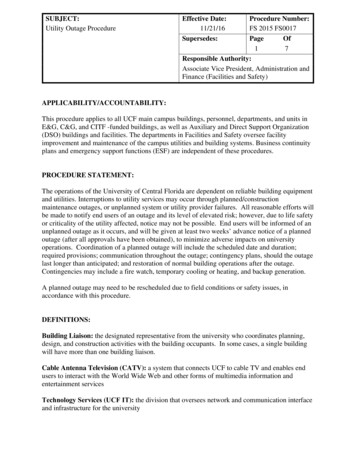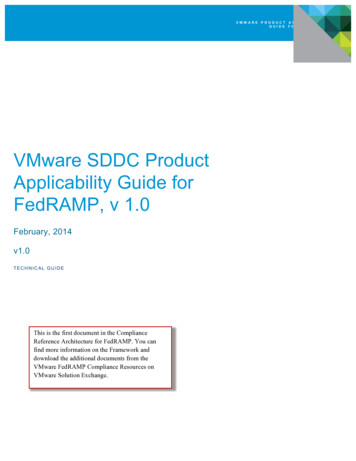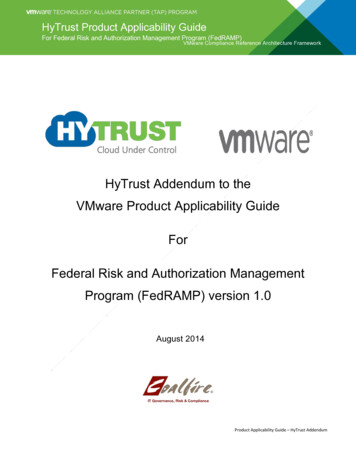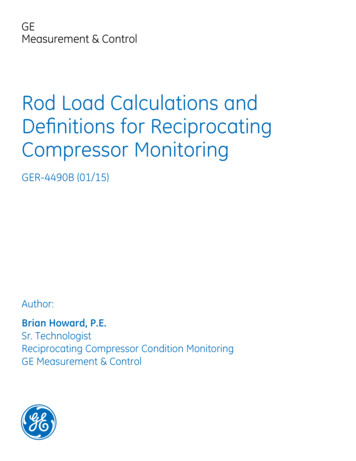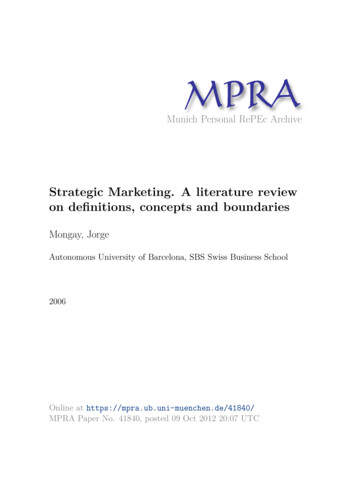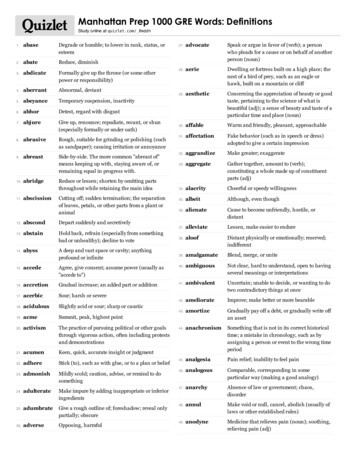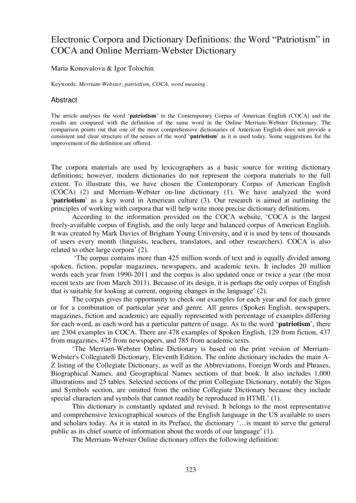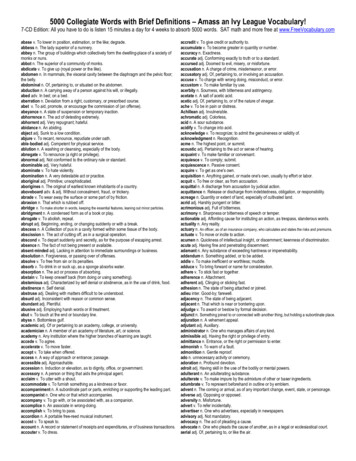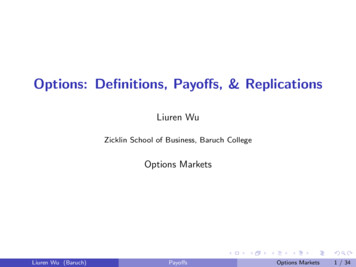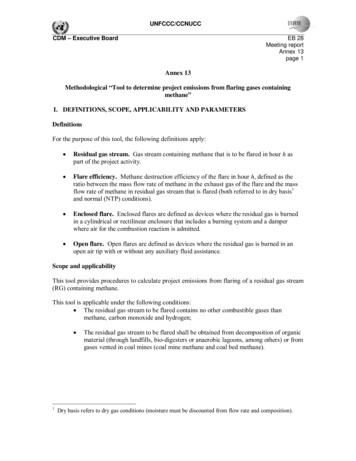
Transcription
UNFCCC/CCNUCCCDM – Executive BoardEB 28Meeting reportAnnex 13page 1Annex 13Methodological “Tool to determine project emissions from flaring gases containingmethane”I. DEFINITIONS, SCOPE, APPLICABILITY AND PARAMETERSDefinitionsFor the purpose of this tool, the following definitions apply: Residual gas stream. Gas stream containing methane that is to be flared in hour h aspart of the project activity. Flare efficiency. Methane destruction efficiency of the flare in hour h, defined as theratio between the mass flow rate of methane in the exhaust gas of the flare and the massflow rate of methane in residual gas stream that is flared (both referred to in dry basis1and normal (NTP) conditions). Enclosed flare. Enclosed flares are defined as devices where the residual gas is burnedin a cylindrical or rectilinear enclosure that includes a burning system and a damperwhere air for the combustion reaction is admitted. Open flare. Open flares are defined as devices where the residual gas is burned in anopen air tip with or without any auxiliary fluid assistance.Scope and applicabilityThis tool provides procedures to calculate project emissions from flaring of a residual gas stream(RG) containing methane.This tool is applicable under the following conditions: The residual gas stream to be flared contains no other combustible gases thanmethane, carbon monoxide and hydrogen; 1The residual gas stream to be flared shall be obtained from decomposition of organicmaterial (through landfills, bio-digesters or anaerobic lagoons, among others) or fromgases vented in coal mines (coal mine methane and coal bed methane).Dry basis refers to dry gas conditions (moisture must be discounted from flow rate and composition).
UNFCCC/CCNUCCCDM – Executive BoardEB 28Meeting reportAnnex 13page 2ParametersThis tool provides procedures to determine the following parameters :Parameter SI UnitDescriptionPEflare,ytCO2eProject emissions from flaring of the residual gas stream in year yηflare,hFlare efficiency in hour h based on measurements or defaultvalues.The following data are required by this tool:ParameterSI UnitDescriptionfvi,hVolumetric fraction of component i in the residual gas in the hourh where i CH4, CO, CO2, O2, H2, N2FVRG,hm3/hVolumetric flow rate of the residual gas in dry basis at normal(NTP) conditions2 in the hour htO2,h-fvCH4,FG,hmg/m3Tflare CVolumetric fraction of O2 in the exhaust gas of the flare in the hourh (only in case the flare efficiency is continuously monitored)Concentration of methane in the exhaust gas of the flare in drybasis at normal conditions in the hour h (only in the case the flareefficiency is continuously monitored)Temperature in the exhaust gas of the enclosed flareAny other parameters required to monitor proper operation of theflare according to the manufacturer’s specification (only in thecase of use of a default value for the flare efficiency of enclosedand open flares)II. BASELINE METHODOLOGY PROCEDUREProject emissions from flaring of the residual gas stream are calculated based on the flareefficiency and the mass flow rate of methane in the residual gas stream that is flared. The flareefficiency depends on both the actual efficiency of combustion in the flare and the time that theflare is operating. The efficiency of combustion in the flare is calculated from the methanecontent in the exhaust gas of the flare, corrected for the air used in the combustion process, andthe methane content in the residual gas.In case of open flares, the flare efficiency cannot be measured in a reliable manner (i.e. externalair will be mixed and will dilute the remaining methane) and a default value of 50%3 is to be usedprovided that it can be demonstrated that the flare is operational (e.g. through a flame detectionsystem reporting electronically on continuous basis)). If the flare is not operational the defaultvalue to be adopted for flare efficiency is 0%.23Normal (NTP) conditions are 101.325 kPa and 273.15 K.Whenever the default value for the flare efficiency (either open flare or enclosed flare) is to be used forcalculation of project emissions in equation 15 below, the value should be converted into fraction (e.g.50/100 0.5) before use in the equation.
UNFCCC/CCNUCCCDM – Executive BoardEB 28Meeting reportAnnex 13page 3For enclosed flares, the temperature in the exhaust gas of the flare is measured to determinewhether the flare is operating or not.For enclosed flares, either of the following two options can be used to determine the flareefficiency:(a) To use a 90% default value. Continuous monitoring of compliance with manufacturer’sspecification of flare (temperature, flow rate of residual gas at the inlet of the flare) mustbe performed. If in a specific hour any of the parameters are out of the limit ofmanufacturer’s specifications, a 50% default value for the flare efficiency should be usedfor the calculations for this specific hour.(b) Continuous monitoring of the methane destruction efficiency of the flare (flareefficiency).In both cases, if there is no record of the temperature of the exhaust gas of the flare or if therecorded temperature is less than 500 C for any particular hour, it shall be assumed that duringthat hour the flare efficiency is zero.Project participants should document in the CDM-PDD, which type of flare and which approachto determine the flare efficiency is used. In case of use of the default value for the methanedestruction efficiency, the manufacturer’s specifications for the operation of the flare and therequired data and procedures to monitor these specifications should be documented in the CDMPDD.This tool involves the following seven steps:STEP 1: Determination of the mass flow rate of the residual gas that is flaredSTEP 2: Determination of the mass fraction of carbon, hydrogen, oxygen and nitrogen in theresidual gasSTEP 3: Determination of the volumetric flow rate of the exhaust gas on a dry basisSTEP 4: Determination of methane mass flow rate of the exhaust gas on a dry basisSTEP 5: Determination of methane mass flow rate of the residual gas on a dry basisSTEP 6: Determination of the hourly flare efficiencySTEP 7: Calculation of annual project emissions from flaring based on measured hourly valuesor based on default flare efficiencies.Project participants shall apply these steps to calculate project emissions from flaring (PEflare,y)based on the measured hourly flare efficiency or based on the default values for the flareefficiency (ηflare,h). Note that steps 3 and 4 are only applicable in case of enclosed flares andcontinuous monitoring of the flare efficiency.The calculation procedure in this tool determines the flow rate of methane before and after thedestruction in the flare, taking into account the amount of air supplied to the combustion reactionand the exhaust gas composition (oxygen and methane). The flare efficiency is calculated foreach hour of a year based either on measurements or default values plus operational parameters.Project emissions are determined by multiplying the methane flow rate in the residual gas withthe flare efficiency for each hour of the year.
UNFCCC/CCNUCCCDM – Executive BoardEB 28Meeting reportAnnex 13page 4
UNFCCC/CCNUCCCDM – Executive BoardEB 28Meeting reportAnnex 13page 5STEP 1. Determination of the mass flow rate of the residual gas that is flaredThis step calculates the residual gas mass flow rate in each hour h, based on the volumetric flowrate and the density of the residual gas. The density of the residual gas is determined based on thevolumetric fraction of all components in the gas.FM RG , h ρ RG , n , h FVRG , hWhere:VariableFMRG,hρRG,n,hFVRG,hSI Unitkg/hkg/m3m3/h(1)DescriptionMass flow rate of the residual gas in hour hDensity of the residual gas at normal conditions in hour hVolumetric flow rate of the residual gas in dry basis at normalconditions in the hour hand:ρ RG , n, h Where:VariableρRG,n,hPnRuMMRG,hTnPn(2)Ru TnMM RG , hSI Unitkg/m3PaPa.m3/kmol.Kkg/kmolKDescriptionDensity of the residual gas at normal conditions in hour hAtmospheric pressure at normal conditions (101 325)Universal ideal gas constant (8 314)Molecular mass of the residual gas in hour hTemperature at normal conditions (273.15)and:MM RG , h ( fvi ,h * MM i )(3)iWhere:VariableMMRG,hfvi,hMMiISI Unitkg/kmolkg/kmolDescriptionMolecular mass of the residual gas in hour hVolumetric fraction of component i in the residual gas in thehour hMolecular mass of residual gas component iThe components CH4, CO, CO2, O2,H2, N2As a simplified approach, project participants may only measure the volumetric fraction ofmethane and consider the difference to 100% as being nitrogen (N2).
UNFCCC/CCNUCCCDM – Executive BoardEB 28Meeting reportAnnex 13page 6STEP 2. Determination of the mass fraction of carbon, hydrogen, oxygen and nitrogen inthe residual gasDetermine the mass fractions of carbon, hydrogen, oxygen and nitrogen in the residual gas,calculated from the volumetric fraction of each component i in the residual gas, as follows:fm j, h fvWhere:Variablefmj,hfvi,hAMjNAj,iMMRG,hjii, h AM j NA j,ii(4)MM RG,hSI Unitkg/kmolkg/kmolDescriptionMass fraction of element j in the residual gas in hour hVolumetric fraction of component i in the residual gas in thehour hAtomic mass of element jNumber of atoms of element j in component iMolecular mass of the residual gas in hour hThe elements carbon, hydrogen, oxygen and nitrogenThe components CH4, CO, CO2, O2,H2, N2STEP 3. Determination of the volumetric flow rate of the exhaust gas on a dry basisThis step is only applicable if the methane combustion efficiency of the flare is continuouslymonitored.Determine the average volumetric flow rate of the exhaust gas in each hour h based on astoichiometric calculation of the combustion process, which depends on the chemicalcomposition of the residual gas, the amount of air supplied to combust it and the composition ofthe exhaust gas, as follows:TVn, FG , h Vn, FG , h FM RG , hWhere:VariableTVn,FG,hVn,FG,hFMRG,hSI Unitm3/hm3/kg residualgaskg residualgas/h(5)DescriptionVolumetric flow rate of the exhaust gas in dry basis at normalconditions in hour hVolume of the exhaust gas of the flare in dry basis at normalconditions per kg of residual gas in hour hMass flow rate of the residual gas in the hour h
UNFCCC/CCNUCCCDM – Executive BoardEB 28Meeting reportAnnex 13page 7Vn, FG , h Vn ,CO2 , h Vn, O2 , h Vn, N 2 , hWhere:VariableVn,FG,hVn,CO2,hVn,N2,hVn,O2,hSI Unitm3/kg residualgasm3/kg residualgasm3/kg residualgasm3/kg residualgas(6)DescriptionVolume of the exhaust gas of the flare in dry basis at normalconditions per kg of residual gas in the hour hQuantity of CO2 volume free in the exhaust gas of the flare atnormal conditions per kg of residual gas in the hour hQuantity of N2 volume free in the exhaust gas of the flare atnormal conditions per kg of residual gas in the hour hQuantity of O2 volume free in the exhaust gas of the flare atnormal conditions per kg of residual gas in the hour hVn, O2 , h nO2 , h MVnWhere:VariableVn,O2,hnO2,hMVnSI Unitm3/kg residualgaskmol/kgresidual gasm3/kmol(7)DescriptionQuantity of O2 volume free in the exhaust gas of the flare atnormal conditions per kg of residual gas in the hour hQuantity of moles O2 in the exhaust gas of the flare per kgresidual gas flared in hour hVolume of one mole of any ideal gas at normal temperature andpressure (22.4 L/mol) fm N ,h 1 MFO2 Vn, N 2 , h MVn 200 AM N MFO2Where:VariableVn,N2,hMVnfmN,hAMnMFO2FhnO2,hSI Unitm3/kgresidual gasm3/kmolkg/kmolkmol/kgresidual gaskmol/kgresidual gas * Fh nO , h2 [ ] (8)DescriptionQuantity of N2 volume free in the exhaust gas of the flare atnormal conditions per kg of residual gas in the hour hVolume of one mole of any ideal gas at normal temperature andpressure (22.4 m3/Kmol)Mass fraction of nitrogen in the residual gas in the hour hAtomic mass of nitrogenO2 volumetric fraction of airStochiometric quantity of moles of O2 required for a completeoxidation of one kg residual gas in hour hQuantity of moles O2 in the exhaust gas of the flare per kgresidual gas flared in hour h
UNFCCC/CCNUCCCDM – Executive BoardVn, CO2 , h Where:VariableVn,CO2,hfmC,hAMCMVnnO2 , h (tO2,hMFO2Fhfmj,hAMjjAMjj(9)SI Unitm3/kg residualgaskg/kmolm3/kmoltO 2 , hSI Unitkmol/kgresidual gaskmol/kgresidual gaskg/kmolDescriptionQuantity of CO2 volume free in the exhaust gas of the flare atnormal conditions per kg of residual gas in the hour hMass fraction of carbon in the residual gas in the hour hAtomic mass of carbonVolume of one mole of any ideal gas at normal temperature andpressure (22.4 m3/Kmol))SI Unitkmol O2/kgresidual gaskg/kmol Fh (10)DescriptionQuantity of moles O2 in the exhaust gas of the flare per kgresidual gas flared in hour hVolumetric fraction of O2 in the exhaust gas in the hour hVolumetric fraction of O2 in the air (0.21)Stochiometric quantity of moles of O2 required for a completeoxidation of one kg residual gas in hour hMass fraction of element j in the residual gas in hour h (fromequation 4)Atomic mass of element jThe elements carbon (index C) and nitrogen (index N)fmC , hfmH , hfmO , h AM C 4 AM H 2 AM OWhere:VariableFhfmj,hfmC , h MVnAM C fmfmN , h 1 MFO2 C,h 1 (tO2 , h / MFO2 ) AM C 2 AM N MFO2 Where:VariablenO2,hFh EB 28Meeting reportAnnex 13page 8(11)DescriptionStoichiometric quantity of moles of O2 required for a completeoxidation of one kg residual gas in hour hMass fraction of element j in the residual gas in hour h (fromequation 4)Atomic mass of element jThe elements carbon (index C), hydrogen (index H) and oxygen(index O)
UNFCCC/CCNUCCCDM – Executive BoardEB 28Meeting reportAnnex 13page 9STEP 4. Determination of methane mass flow rate in the exhaust gas on a dry basisThis step is only applicable if the methane combustion efficiency of the flare is continuouslymonitored.The mass flow of methane in the exhaust gas is based on the volumetric flow of the exhaust gasand the measured concentration of methane in the exhaust gas, as follows:(12)TM FG , h Where:VariableTMFG,hTVn,FG,hfvCH4,FG,hTVn , FG , h * fv CH 4 , FG , h1000000SI Unitkg/hm3/h exhaustgasmg/m3DescriptionMass flow rate of methane in the exhaust gas of the flare in drybasis at normal conditions in the hour hVolumetric flow rate of the exhaust gas in dry basis at normalconditions in hour hConcentration of methane in the exhaust gas of the flare in drybasis at normal conditions in hour hSTEP 5. Determination of methane mass flow rate in the residual gas on a dry basisThe quantity of methane in the residual gas flowing into the flare is the product of the volumetricflow rate of the residual gas (FVRG,h), the volumetric fraction of methane in the residual gas(fvCH4,RG,h) and the density of methane (ρCH4,n,h) in the same reference conditions (normalconditions and dry or wet basis).It is necessary to refer both measurements (flow rate of the residual gas and volumetric fraction ofmethane in the residual gas) to the same reference condition that may be dry or wet basis. If theresidual gas moisture is significant (temperature greater than 60ºC), the measured flow rate of theresidual gas that is usually referred to wet basis should be corrected to dry basis due to the factthat the measurement of methane is usually undertaken on a dry basis (i.e. water is removedbefore sample analysis).TM RG , h FVRG , h fvCH 4, RG , h ρ CH 4, nWhere:VariableTMRG,hFVRG,hSI Mass flow rate of methane in the residual gas in the hour hVolumetric flow rate of the residual gas in dry basis at normalconditions in hour hVolumetric fraction of methane in the residual gas on dry basisin hour h (NB: this corresponds to fvi,RG,h where i refers tomethane).Density of methane at normal conditions (0.716)
UNFCCC/CCNUCCCDM – Executive BoardEB 28Meeting reportAnnex 13page 10STEP 6. Determination of the hourly flare efficiencyThe determination of the hourly flare efficiency depends on the operation of flare (e.g.temperature), the type of flare used (open or enclosed) and, in case of enclosed flares, theapproach selected by project participants to determine the flare efficiency (default value orcontinuous monitoring).In case of enclosed flares and continuous monitoring of the flare efficiency, the flare efficiencyin the hour h (ηflare,h) is 0% if the temperature of the exhaust gas of the flare (Tflare) is below 500 C during morethan 20 minutes during the hour h.determined as follows in cases where the temperature of the exhaust gas of the flare(Tflare) is above 500 C for more than 40 minutes during the hour h :η flare, h 1 Where:Variableηflare,hTMFG,hSI Unitkg/hTMRG,hkg/hTM FG , hTM RG , h(14)DescriptionFlare efficiency in the hour hMethane mass flow rate in exhaust gas averaged in aperiod of time t (hour, two months or year)Mass flow rate of methane in the residual gas in the hourhIn case of enclosed flares and use of the default value for the flare efficiency, the flareefficiency in the hour h (ηflare,h) is: 0% if the temperature in the exhaust gas of the flare (Tflare) is below 500 C for more than20 minutes during the hour h .50%, if the temperature in the exhaust gas of the flare (Tflare) is above 500 C for morethan 40 minutes during the hour h, but the manufacturer’s specifications on properoperation of the flare are not met at any point in time during the hour h.90%, if the temperature in the exhaust gas of the flare (Tflare) is above 500 C for morethan 40 minutes during the hour h and the manufacturer’s specifications on properoperation of the flare are met continuously during the hour h.In case of open flares, the flare efficiency in the hour h (ηflare,h) is 0% if the flame is not detected for more than 20 minutes during the hour h.50%, if the flare is detected for more than 20 minutes during the hour h.
UNFCCC/CCNUCCCDM – Executive BoardEB 28Meeting reportAnnex 13page 11STEP 7. Calculation of annual project emissions from flaringProject emissions from flaring are calculated as the sum of emissions from each hour h, based onthe methane flow rate in the residual gas (TMRG,h) and the flare efficiency during each hour h(ηflare,h), as follows:PE flare, y TM RG ,h (1 η flare ,h ) 8760h 1Where:VariablePEflare,ySI UnittCO2eTMRG,hηflare,hGWPCH4kg/htCO2e/tCH4GWPCH 41000(15)DescriptionProject emissions from flaring of the residual gas stream in yearyMass flow rate of methane in the residual gas in the hour hFlare efficiency in hour hGlobal Warming Potential of methane valid for the commitmentperiodData and parameters not monitoredThe only parameters and data that is not monitored are the constants used in equations, as listed inTable 1 below.Table 1. Constants used in equationsParameterSI UnitDescriptionMMCH4kg/kmolMolecular mass of methaneMMCOkg/kmolMolecular mass of carbon monoxideMMCO2kg/kmolMolecular mass of carbon dioxideMMO2kg/kmolMolecular mass of oxygenMMH2kg/kmolMolecular mass of hydrogenMMN2kg/kmolMolecular mass of nitrogenAMckg/kmolAtomic mass of carbon(g/mol)AMhkg/kmolAtomic mass of hydrogen(g/mol)AMokg/kmolAtomic mass of oxygen(g/mol)AMnkg/kmolAtomic mass of nitrogen(g/mol)PnPaAtmospheric pressure at normal conditionsRuPa.m3/kmol.KUniversal ideal gas constantTnKTemperature at normal conditionsMFO2Dimensionless O2 volumetric fraction of airGWPCH4tCO2/tCH4Global warming potential of methaneMVnm3/KmolVolume of one mole of any ideal gas at 6.0014.01101 3258 314.472273.150.212122.414
UNFCCC/CCNUCCCDM – Executive BoardParameterSI Unitρ CH4, nNAi,jkg/m3DimensionlessEB 28Meeting reportAnnex 13page 12Descriptiontemperature and pressureDensity of methane gas at normal conditionsNumber of atoms of element j in component i,depending on molecular structureValue0.716III. MONITORING METHODOLOGY PROCEDUREData and parameters to be monitoredAll monitored data must
Meeting report Annex 13 page 2 Parameters This tool provides procedures to determine the following parameters : Parameter SI Unit Description PEflare,y tCO2e Project emissions from flaring of the residual gas stream in year y ηflare,h - Flare effi


